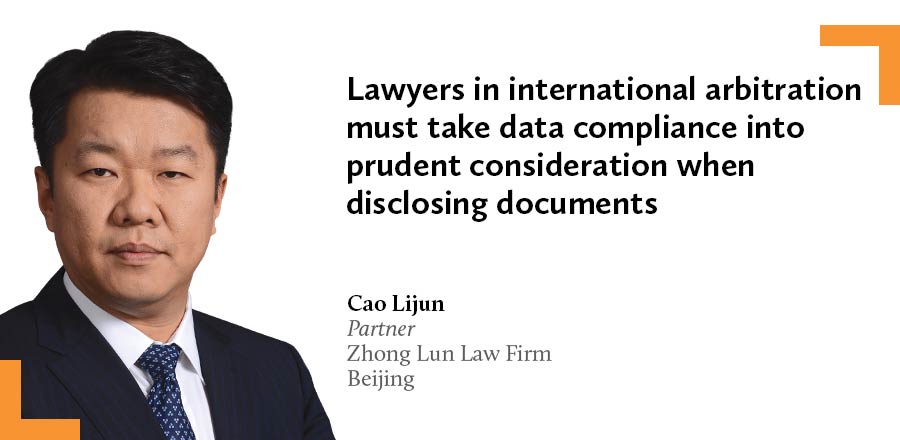When the going gets tough, inspirational thinking comes to the fore. Small wonder that the past couple of years have spawned an exciting amount of tech-related reform in China’s courts and arbitration institutions. Kevin Cheng reports
In October, the US government enacted sweeping restrictions over the export of technology, software and equipment used for producing advanced computing chips and supercomputers to China’s semiconductor and hardware industry, which has seen a streak of encouraging growth over the years but still relies considerably on imported know-how.
This is perceived as a drastic escalation from the ongoing trade war between the world’s two largest economies, which began in 2018, as well as a hefty roadblock to the global trade network, already plagued by geopolitical and macroeconomic impediments that seem to be popping up faster than they can be resolved.
Upon hearing the news, China-based entrepreneurs, overseas investors and legal professionals jotted down this unfortunate development onto their list of concerns, and promptly set out to schedule a top-down risk assessment of all existing and planned operations.
On that list, the new entry closely follows the recurring pandemic and potential lockdowns, the war in Ukraine and the Western world’s sanctions against Russia, deteriorating geopolitical stability, interest rate hikes and the looming recession, and shortages across the global supply chain.
Tested during these trying times is not only the business acumen of corporate executives determined to sail beyond the national border, but also the expertise of their law practising convoys and the wisdom of China’s evolving judicial system, dedicated to help maintain trade vitality when disputes are constantly one factor – beyond either party’s reach – away.
TACKLING CROSS-BORDER DILEMMA
“These adverse macroeconomic factors, along with a growing phenomenon of generalising ‘national security’, manifested as wanton decoupling and other acts of reverse globalisation, are making it difficult for the world economy to recuperate and grow,” says David Jia, a Shenzhen-based senior partner at Long An Law Firm.
Referring to the “chip 4 alliance” advocated by the US to form a global semiconductor supply and co-ordination network comprising Japan, South Korea and Taiwan, Jia adds: “It not only concerns the interests of Chinese and American companies, but also how the chip industry chain will reform and develop on a global scale, which obviously will lead to more cross-border disputes.”
Jia is not alone in his observation that a volatile and unpredictable international business environment begets a growing number of cross-border disputes and challenges long-held precedents in international trade.
According to Zhang Lixia, a founding partner of Huamao & Guigu Law Firm, more companies looking to consult or engage their services are claiming that due to the pandemic or the Sino-US trade breakdown, their contracts can no longer move ahead, or have met major obstacles, leaving lawsuits or arbitration their only recourse.
Likewise, Chen Xiaoshan, head of international arbitration at the Shanghai office of DLA Piper, sees an uptick in the frequency of cross-border disputes. “In the past year, due to covid-19, we have handled a large number of international trade disputes relating to the cross-border sale and purchase of personal protective equipment (PPE) and force majeure clause,” he says. “In the meantime, disputes directly or indirectly relating to the Russia-Ukraine war, especially those arising out of international trade and transportation, have also significantly increased.”
The trend is also reflected in the published statistics of leading arbitration venues, as with the 2021 work report of the China International Economic and Trade Arbitration Commission (CIETAC). According to the report, CIETAC handled a record high of 4,071 cases in 2021, a year-on-year increase of 12.6%, of which 636 were foreign-related (including those related to Hong Kong, Macau and Taiwan), representing a significant increase.
According to Cao Lijun, a partner at Zhong Lun Law Firm in Beijing, we have yet to see the peak of international disputes related to the Ukraine-Russia war or the pandemic. “Considering the hysteretic nature of disputes, the numbers are likely to continue climbing for some time,” he predicts.
Chris Zhang, the senior partner of Jincheng Tongda & Neal based in the firm’s Shanghai office, looks at macroeconomic factors from a dialectical perspective. “On one hand, as foreign trade is riddled with uncertainties during the pandemic, China’s seen a decline in its total amount of cross-border business activities,” she says, but on the other hand, also as a result of the pandemic, what foreign trade there is has become more likely to produce disputes.
“Due to the war in Ukraine, and the numerous Western sanctions against Russia’s major exporters and their executives, Chinese businesses must sometimes breach their contracts with original partners to avoid being sanctioned by the EU and US,” says Zhang. “This adds to the likelihood of cross-border disputes.”
Even more damaging, the stagnation of the global supply chain has not only increased the volume of international disputes but also added to their complexity and difficulty.
During Shanghai’s two-month lockdown earlier in the year, Shanghai Port suffered from labour shortages, overpacked warehouses and logistics chain paralysis, which halted the circulation of domestic and international goods in their tracks, leading to a series of discords.
Zhang says that while the Civil Code and other laws and judicial interpretations have made force majeure a viable defence for pandemic-induced defaults, these cross-border contracts may not be governed by Chinese law.
“In addition, exports of masks, medical gloves, antigen testing and other anti-pandemic supplies were restricted, as they were required to be first distributed to covid-affected regions in China,” she observes. “Consequently, domestic vendors faced lawsuits and arbitrations from overseas buyers, and had to deal with a compromised reputation.”
Zhang Guanglei, a partner at the Beijing head office of Jingtian & Gongcheng, believes that macro headwinds have made contract performance a challenge, and whether that is enough to trigger force majeure, or constitute a “change of situation”, may become the focal point of cross-border disputes. “Furthermore, these adverse factors have made it difficult to obtain evidence in cross-border proceedings,” he adds.
Ray Liu, a global partner at Dorsey and head of its Beijing office, believes the surge in disputes reflects, to a degree, China’s rapid development in both traditional and new-tech sectors, contributing to their stronger presence on the international stage that has now fallen victim to macroeconomic uncertainty.
“Covid-19 cut down the opportunities for courts, clients and other parties to meet face to face, which makes it hard to regulate the procedure and for parties to negotiate in the same room,” says Liu. “With uncertainties seeping into the global economy, many enterprises have seen a sharp decline in their revenue, leading to a series of contractual, labour and financing-related disputes.”
Chris Zhang, of Jincheng Tongda & Neal, holds incompatibility between foreign and Chinese laws as one of the chief catalysts for cross-border strife, citing Cadence Design Systems v Syntronic (2022) as one such case.
The California Northern District Court ordered the defendant to send 24 computers from China to the US for inspection, to which the defensive lawyer argued that, as these computers contained the protected personal information of the employees, according to article 39 of the Personal Information Protection Law (PIPL), they can only be moved out of China with employees’ individual consent.
However, the judge deemed that the exception under the clause – permission to transfer personal information “where necessary to fulfil statutory duties and responsibilities or statutory obligations” – should apply to foreign legal obligations, and persisted with his decision.
You must be a
subscribersubscribersubscribersubscriber
to read this content, please
subscribesubscribesubscribesubscribe
today.
For group subscribers, please click here to access.
Interested in group subscription? Please contact us.
你需要登录去解锁本文内容。欢迎注册账号。如果想阅读月刊所有文章,欢迎成为我们的订阅会员成为我们的订阅会员。
Practitioner’s Perspective Article Series
International arbitration procedures and key pointsBy Jiang Hong and Gong Yiduo, TianTong Law Firm |
 |
Guide to drafting the arbitration clauseBy Wang Jialu and Hu Jian, Commerce & Finance Law Offices |
 |
Validity of arbitration agreement from case filing perspectiveBy Tian Bin, Langfang Arbitration Commission |
 |
Pre-hearing preparation and post-hearing response to arbitrationBy Li Fei, Langfang Arbitration Commission |
 |
Remedies against malicious transfer of invested companiesBy Liu Jing and Qi Hanwei, Han Kun Law Offices |
 |
IP owners should use investigation orders to defend their rights
|
 |
Neglect of liquidation duties by limited company shareholdersBy Zhu Qimin and Yin Shi, Han Kun Law Offices |
 |
Obstacles with repurchase agreements by target companiesBy Cui Qiang, Commerce & Finance Law Offices |
 |
Seller’s liability in financial asset management disputesBy Gao Ping, AnJie & Broad Law Firm |
 |
HK has edge for foreign funds’ arbitration of property divestment disputesBy Wu Ming and Shen Junjie, Dentons China |
 |
Adjudicating concurrent IP protection and unfair competition claimsBy Li Chunyi, Zhongzi Law Office |
 |
HK enforcement of mainland judgments, arbitral awardsBy Lam Sek Kong and Vivien Li, Guantao Law Firm |
 |
Analysis of Shanghai’s first data compliance caseBy Zhou Kairen and Bao Wei, Llinks Law Offices |
 |
CIETAC’s latest emergency arbitration: an inside look
|
 |
Third-party funding in post-pandemic eraBy Mariana Zhong and Yang Xueyu, Hui Zhong Law Firm |
 |
Application of international sports dispute mediation mechanismBy Jia Xiangming and Li Jiayao, Zhongzi Law Office |
 |























